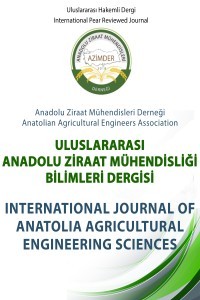
Uluslararası Anadolu Ziraat Mühendisliği Bilimleri Dergisi
Yazarlar: Aişe DELİBORAN, Kerem SAVRAN, Özgür DURSUN, Önder ERALP, Tülin PEKCAN, Hatice Sevim TURAN, EROL AYDOĞDU, İS ÇILGIN, HANDAN ATAOL ÖLMEZ, ŞULE SAVRAN, ABDULLAH SUAT NACAR, Erol AYDOĞDU, İs ÇILGIN, Ahandan ATAOL ÖLMEZ, Şule SAVRAN, Abdullah Suat NACAR
Konular:Ziraat, Toprak Bilimi
Anahtar Kelimeler:Olive,Boron,Soil fertility,Plant nutrition,Micro element
Özet: Study was conducted to determine the nutritional status of olive cultivated land and olive plant in Muğla province in terms of boron and other elements. For this purpose, soil and leaf samples were collected from 125 gardens in Datca, Koycegiz, Milas, Ula, Seydikemer In soil sample were made texture, soil reaction, electrical conductivity, lime, organic matter, extractable boron, iron, cooper, zinc and manganese analysez. In plants samples were determined total boron, iron, cooper, zinc and manganese. The vast majority of soils has sandy-tin and clayey-tin structure and low organic matter content. Lightly alkaline, neutral and medium acidic soils are in the salt-free class and contain about high lime. Although all of the soil contains sufficient boron, the lack of boron in 93% of the leaves indicates that the plant doesn’t benefit from the existing boron. There was serious nutritional problems in terms of B, and Zn and Fe, Cu and Mn. Also, secure correlative relationships between the amounts of nutrient in the soil and the amounts of nutrient in the leaf were obtained. Considering the results of this study, it is said that effective fertilization program, method and time are extremely important. High quality and high yield production balanced fertilization, addition of organic fertilizers and other technical applications.
Dergi editörleri editör girişini kullanarak sisteme giriş yapabilirler. Editör girişi için tıklayınız.